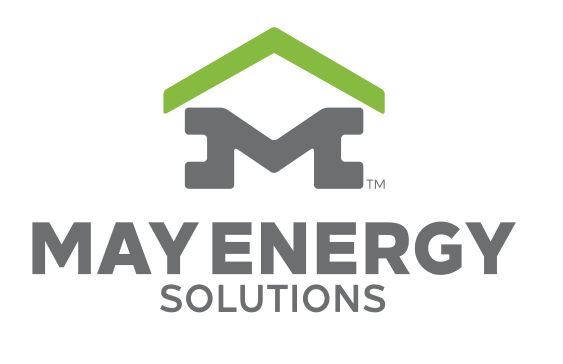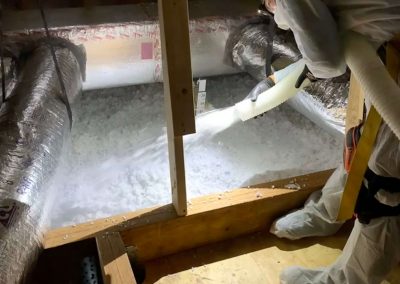BlowN-In Insulation
Attics
Struggling with high energy bills and inconsistent indoor temperatures? At May Energy Solutions, we understand the challenges homeowners face without proper insulation. That’s why we offer top-quality blown-in insulation services across south central Texas. Our advanced insulation solutions are perfect for both new construction and existing homes, providing a quick and effective way to boost your attic’s insulation performance. Excellent feedback and ratings by our previous clients make us the top pick when you look for blown-in insulation near me. So, what are you waiting for? Contact us today for your home evaluation.
For the majority of homes built in the last 20 to 30 years, the most common type of attic insulation in Texas and most of the US is blown-in or loose-fill insulation. It has advantages over batts that were used previously for easier installation, and since it is loose fill, it fills easily around all the differently shaped materials in an attic, such as framing lumber, plumbing pipes, electrical wires, and HVAC ducts. The most popular for lower-budget homes has been fiberglass because it was inexpensive and faster to install. In recent years, the costs of fiberglass have gone up significantly. The remainder of attics are insulated with blown-in cellulose, which has advantages in R-value, cost, and performance.
Before

After

Customers can choose between cellulose and fiberglass for their attic insulation. See FAQ page for why May Energy Solutions prefers loose fill cellulose insulation.
Walls
May Energy Solutions can install insulation in walls of older homes with no existing insulation, provided the wall construction is compatible with sheet rock on the inside and plywood or other sheathing on the outside. Loose fill cellulose is blown in through holes drilled in the walls (a method called “dense packing”). Tightly packed cellulose fills the wall cavity and gaps around wires, pipes and electrical boxes. The dense packing prevents settling, provides resistance to air leakage, and great insulation performance.
For houses with siding, a strip or two of siding is removed and a 2 inch diameter hole is drilled into the exterior plywood sheathing in each stud cavity. After the insulation is blown in, the holes are filled with plugs and the siding is reinstalled.
For houses with a brick exterior, access to the wall cavity can be achieved in two different ways. The holes can be drilled in the interior drywall, which are then patched and textured to match the interior finish after the insulation is installed. This method makes for quicker insulation installation, but more finish work is required after and there are challenges to matching texture and paint. Holes can be drilled in the mortar between the brick to blow in the insulation, however these holes are small so the installation takes a bit longer. Afterwards the holes are sealed up with mortar.


*Note: In the table at right , CI stands for “continuous insulation” that is applied to the exterior of the wall assembly just inside the cladding. Map and chart: www.energy.gov/energysaver/insulation
Blown-in Insulation in Texas
Struggling with high energy bills and inconsistent indoor temperatures? At May Energy Solutions, we understand the challenges homeowners face without proper insulation. That’s why we offer top-quality blown-in insulation services across south central Texas. Our advanced insulation solutions are perfect for both new construction and existing homes, providing a quick and effective way to boost your attic’s insulation performance. Excellent feedback and ratings by our previous clients make us the top pick when you look for blown-in insulation near me. So, what are you waiting for? Contact us today for your home evaluation.
For the majority of homes built in the last 20 to 30 years, the most common type of attic insulation in Texas and most of the US is blown-in or loose-fill insulation. It has advantages over batts that were used previously for easier installation, and since it is loose fill, it fills easily around all the differently shaped materials in an attic, such as framing lumber, plumbing pipes, electrical wires, and HVAC ducts. The most popular for lower-budget homes has been fiberglass because it was inexpensive and faster to install. In recent years, the costs of fiberglass have gone up significantly. The remainder of attics are insulated with blown-in cellulose, which has advantages in R-value, cost, and performance.
Our Process of Blown-in Insulation
Removing Old Insulation
For a full attic retrofit of an older home, our process begins with removing the old insulation, which, depending on the size of the attic, usually takes 4-6 hours utilizing industrial vacuum equipment and disposal bags made for insulation removal. This is usually done because the old insulation has deteriorated, settled, or is contaminated with dirt, tobacco smoke, mold, or mildew due to water damage or feces or urine from rodent infestation.
Air Sealing for Energy Efficiency
The next step recommended for older homes is air sealing since air leakage can account for up to 40% of energy loss.
Installing Baffles for Proper Airflow
For many homes, adding baffles around the perimeter is needed so the insulation does not block the airflow from the soffits to the exhaust vents in the attic. Baffles also protect the insulation from being blown away from the perimeter by high winds blowing through the soffit vents.
Blowing in New Insulation
The final step in a retrofit is blowing the new insulation to recommended levels, which, depending on the attic size and the insulation level, usually takes 4 to 6 hours for an average house.
For homes with proper air sealing and baffles, whose insulation is in good condition and only needs to be topped off to recommended levels, the only step is to install blown-in insulation on top of the existing insulation. Depending on the attic size and insulation level, this usually takes 2-3 hours.
Our technicians use a commercial grade insulation blower to quickly and efficiently blow in loose fill insulation into the attic. Rulers are installed in the attic to verify the insulation is installed to the proper depth especially in hard to reach areas that can be easy to overlook.
For south Texas, the International Energy Code recommends R49 as shown in the charts below, however New Braunfels only requires R38 which is about 11 or 12 inches of insulation depending on which material is used. We recommend at least R38 for new construction or existing homes. For existing homes whose current insulation is too thin but in good shape, we can easily blow in more insulation to get to the recommended values
Insulation in Walls
May Energy Solutions can install insulation in walls of older homes with no existing insulation, provided the wall construction is compatible with sheet rock on the inside and plywood or other sheathing on the outside. Loose fill cellulose is blown in through holes drilled in the walls (a method called “dense packing”). Tightly packed cellulose fills the wall cavity and gaps around wires, pipes and electrical boxes. The dense packing prevents settling, provides resistance to air leakage, and great insulation performance.
For houses with siding, a strip or two of siding is removed and a 2 inch diameter hole is drilled into the exterior plywood sheathing in each stud cavity. After the insulation is blown in, the holes are filled with plugs and the siding is reinstalled.
For houses with a brick exterior, access to the wall cavity can be achieved in two different ways. The holes can be drilled in the interior drywall, which are then patched and textured to match the interior finish after the insulation is installed. This method makes for quicker insulation installation, but more finish work is required after and there are challenges to matching texture and paint. Holes can be drilled in the mortar between the bricks to blow in the insulation, however these holes are small so the installation takes a bit longer. Afterwards the holes are sealed up with mortar.
Why Choose Blown-in for Your Property?
Blown-in insulation is the most cost-efficient type of attic insulation in terms of initial installation cost and performance. Modern blown-in insulation is durable, resistant to fire, pests, and mold, provides sound deadening, and is very energy efficient when installed with proper air sealing and attic ventilation.





